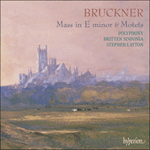Bruckner’s last church composition, Vexilla regis, dates from 1892, four years before the composer’s death, when the ailing Bruckner was struggling to complete his ninth and last symphony. The last thing Bruckner needed at such a time was distraction, yet he insisted that the urge to compose Vexilla regis came ‘straight from the heart’. The use of the old church ‘Phrygian Mode’ (the white-note scale on the piano beginning on E) harks back to Bruckner’s not uncritical interest in the aims of the Cecilian Movement; but the purity of the mode is soon coloured by breathtaking chromatic shifts, and the security of E as the tonal centre is only just recaptured at the end of each verse. The aspiring cadential figure at the word ‘prodeunt’ (‘advance’) near the start echoes Wagner’s use of the old Lutheran ‘Dresden Amen’ in his last opera Parsifal, whose first performance in 1882 had made an enormous impression on Bruckner. (A similar echo can be heard on strings alone near the start of the Adagio of the ninth symphony.)
from notes by Stephen Johnson © 2007
Bruckner composa son dernier ouvrage liturgique, Vexilla regis, en 1892, quatre ans avant de mourir, alors que, déjà malade, il luttait pour achever sa neuvième et dernière symphonie. Il avait alors besoin de tout sauf de distraction mais, insista-t-il, la nécessité de composer Vexilla regis lui jaillit «tout droit du cœur». L’usage du vieux mode ecclésiastique «phrygien» (la gamme en touches blanches qui, au piano, commence à mi) renvoie à l’intérêt tout sauf inconditionnel que Bruckner porta aux desseins du cécilianisme; mais la pureté de ce mode est bientôt teintée d’époustouflantes transitions chromatiques, cependant que la certitude de mi en tant que centre tonal est juste recréée à la fin de chaque verset. L’ambitieuse figure cadentielle au mot «prodeunt» («s’avancent»), vers le début, fait écho à l’usage du vieil «Amen de Dresde» luthérien dans le dernier opéra de Wagner, Parsifal, dont la création, en 1882, avait beaucoup impressionné Bruckner. (Un même écho est décelable aux cordes seules, près du début de l’Adagio de la Symphonie no 9.)
extrait des notes rédigées par Stephen Johnson © 2007
Français: Hyperion Records Ltd
Bruckners letzte kirchenmusikalische Komposition, Vexilla regis, datiert von 1892, vier Jahre vor seinem Tode, als der kränkliche Komponist sich bemühte, seine neunte und letzte Symphonie zu vollenden. Das letzte, was Bruckner zu dieser Zeit brauchte, war eine Ablenkung, aber er bestand darauf, dass die Komposition von Vexilla regis „aus reinem Herzensdrange“ erfolgte. Der Gebrauch der alten phrygischen Kirchentonart (die Tonleiter der weißen Tasten des Klaviers, auf E beginnend), greift auf Bruckners keineswegs unkritisches Interesse am Cäcilianismus zurück, aber die Reinheit des Modus wird bald durch atemberaubende chromatische Verschiebungen eingefärbt, und die Sicherheit des E als tonales Zentrum wird am Ende jeder Strophe nur gerade wieder hergestellt. Die aufstrebende Kadenzfigur auf das Wort „prodeunt“ („treten heraus“) erinnert an Wagners Gebrauch des alten lutherischen „Dresdner Amens“ in seiner letzten Oper Parsifal, deren Uraufführung 1882 einen gewaltigen Eindruck auf Bruckner gemacht hatte. (Ein ähnliches Echo findet sich in den Streichern am Anfang des Adagios der Neunten Symphonie.)
aus dem Begleittext von Stephen Johnson © 2007
Deutsch: Renate Wendel


 Bruckner: Mass & Motets
Bruckner: Mass & Motets BBC Music Magazine» More
BBC Music Magazine» More
